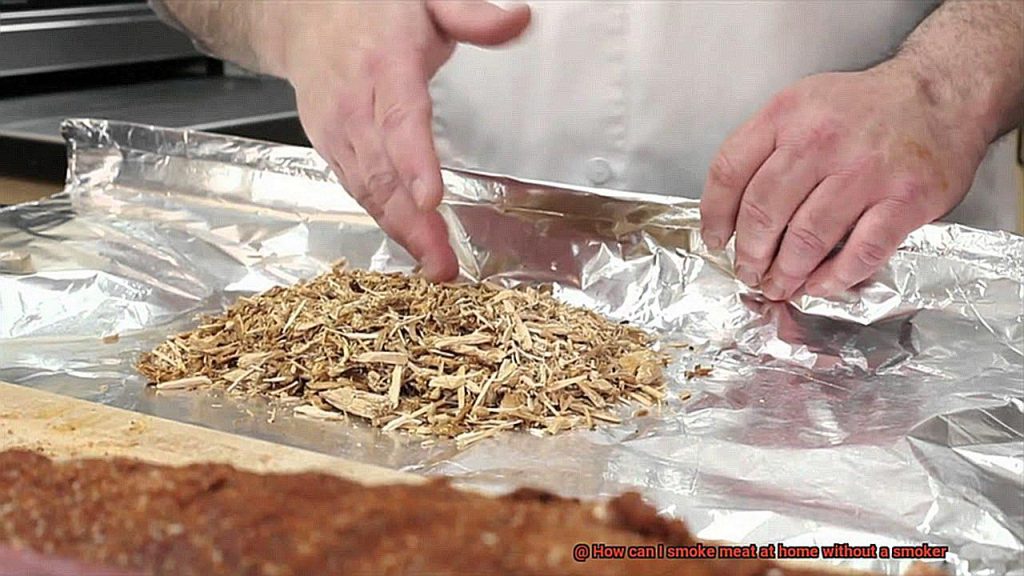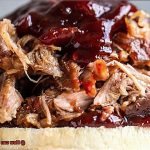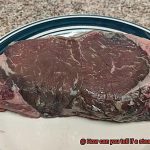Welcome to the world of home smoking, where you can unleash incredible flavors and tantalizing aromas right in your own backyard – no fancy smoker required.
Smoking meat is an ancient tradition that started as a way to preserve food, but it has evolved into a mouthwatering technique that adds that unbeatable smoky taste we all crave. Sure, owning a smoker makes things easier, but don’t fret.
With a little ingenuity and some household items, you can achieve fantastic results. In this blog post, we’ll show you some exciting techniques for smoking meat at home without a smoker.
So grab your apron and prepare to wow your friends and family with dishes that rival those of a seasoned pitmaster. Whether you have a gas or charcoal grill or even just a regular oven, we’ve got you covered.
Let’s dive in and uncover the secrets to creating smoky magic in your own kitchen or backyard.
Contents
What is Smoking Meat?
Smoking meat is a culinary adventure that transports your taste buds to smoky heavens. Whether you’re a BBQ connoisseur or simply a lover of bold flavors, smoking meat is a technique worth exploring. In this article, we will delve into the art of smoking meat, uncovering its secrets and discovering why it has become a beloved cooking method across cultures and cuisines.
The Ancient Preservation Technique:
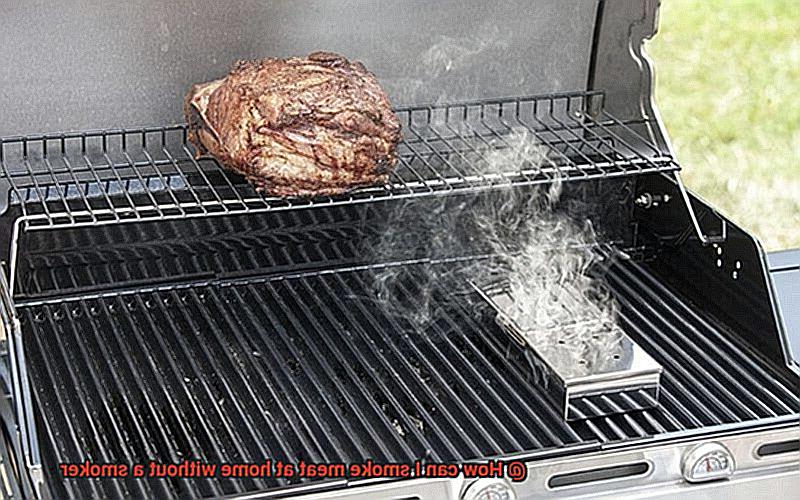
Smoking meat isn’t just about tantalizing your palate; it’s an age-old preservation technique. Before refrigeration, our ancestors smoked meat to extend its shelf life. The smoke acted as a natural preservative, inhibiting bacterial growth and protecting the meat from spoilage. Even today, smoking meat remains popular for its dual benefits of flavor enhancement and preservation.
The Flavor Symphony:
When it comes to flavor, smoking meat takes center stage. As the wood or charcoal burns, it releases aromatic compounds that infuse the meat with a symphony of flavors. Different types of wood contribute distinct flavors, such as the rich sweetness of applewood or the bold intensity of mesquite. Experimentation with various wood types opens up a world of possibilities for creating unique flavor profiles.
The Slow and Steady Cooking Process:
Smoking is not for the impatient cook. It’s a slow and gentle cooking process that requires patience and precision. By maintaining a low and consistent temperature, typically between 200-250°F (93-121°C), the meat slowly cooks over several hours. This slow cooking allows the flavors to penetrate deep into the meat while breaking down tough connective tissues, resulting in incredibly tender and succulent results.
The Equipment: From Smokers to Improvised Setups:
While dedicated smokers are fantastic for smoking meat, you don’t need one to embark on your smoking journey. Grills can be transformed into makeshift smokers by creating separate heat zones and adding soaked wood chips or chunks for smoke. Stovetop smokers provide a compact indoor option, while the oven method allows you to smoke meat without specialized equipment. For those seeking convenience and control, the smoking gun method offers a quick and easy way to infuse smoky goodness.
The Versatility of Smoking:
Smoking is not limited to a specific type of meat. From juicy ribs to mouthwatering briskets, from succulent pork shoulder to tender chicken, smoking enhances the flavors of various cuts. It also extends beyond meat, with smoked vegetables and even fruits finding their place in culinary creations. The possibilities are endless when it comes to exploring the world of smoked delights.
The Grill Method
Step into the realm of culinary delight as we explore the art of smoking meat on a regular grill. For those seeking the tantalizing allure of smoky flavors without the need for a dedicated smoker, The Grill Method is your ultimate solution. With just a few simple steps, you can transform your backyard into a haven of mouthwatering smoked meat. Let us delve into the intricacies and unveil the secrets to achieving smoky perfection.
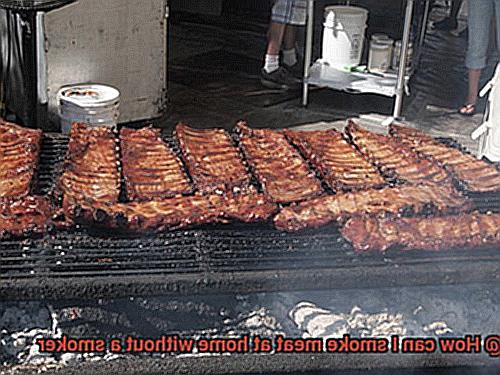
To embark upon this epicurean adventure, the first requirement is a grill with a lid that can be tightly sealed. This crucial element creates an environment conducive to controlled cooking, allowing the meat to slowly simmer and absorb the essence of smokiness.
While charcoal grills are often hailed as the preferred choice for this method due to their ability to impart an authentic smoky taste, fear not if you possess a gas grill. With a touch of ingenuity, you can infuse your gas grill with smokiness by incorporating wood chips or pellets. Soak these wooden wonders in water to prevent them from burning too swiftly and overwhelming the senses with excessive smoke.
Now, let us uncover the enigma of indirect heat. In this ethereal realm, the meat is not placed directly over the heat source but positioned on the opposing side of the grill. As the charcoal or gas burner radiates its heat, it circulates within the confines of the grill, coaxing the meat to surrender to its slow and tender embrace. Succumbing to this gentle heat allows the meat to succulently absorb all those delectable smoky nuances.
To elevate your smoky symphony to new heights, bestow upon it an extra kick of smokiness. Place those soaked wood chips or pellets directly atop the heat source or wrap them lovingly in aluminum foil adorned with tiny vents, granting them freedom to release their aromatic smoke.
As with any journey, vigilance is paramount. Monitor the temperature within the grill with unwavering determination, for it holds the key to smoking success. A trusty thermometer shall be your guide, ensuring that the temperature remains within the desired range. Consistency becomes your muse, prompting adjustments to airflow vents, additional charcoal, or alterations to the gas burner, all in pursuit of maintaining a steady temperature throughout the cooking process.
Behold, for cooking times shall vary based upon the type and size of the meat you choose to enthrall with smoky rapture. Safeguard your culinary masterpiece by wielding a meat thermometer, ensuring that its internal temperature reaches the recommended level of indulgence.
And now, dear epicurean wanderer, exercise patience and restraint in your eagerness to slice and serve your perfectly smoked creation. Allow it to rest for a fleeting moment, permitting its succulent juices to harmoniously redistribute within its tender flesh, bestowing upon it an unparalleled flavor profile.
The Stovetop Method
If you’ve ever found yourself longing for the mouthwatering flavors and tantalizing tenderness of smoked meat, but lack a traditional smoker, fear not. We have the solution you’ve been craving: the Stovetop Method. This ingenious technique allows you to achieve smoky perfection right in the comfort of your own kitchen, using simple equipment you already have. Get ready to embark on a culinary adventure as we guide you through the step-by-step process of using the Stovetop Method to smoke meat at home.
Step 1: Choose your smoking element
To begin, you’ll need to select your preferred wood chips or aromatic herbs. Whether it’s the robust essence of hickory, the delicate sweetness of applewood, or the fragrant allure of rosemary, choose flavors that will complement and enhance your chosen meat. For wood chips, immerse them in water for 30 minutes prior to use, ensuring they produce a steady stream of smoke. If you opt for aromatic herbs, gently crush them to release their delightful flavors.
Step 2: Prepare your meat
While your wood chips are soaking, it’s time to prepare your meat. Allow it to luxuriate in a marinade infused with your desired seasonings or a dry rub that will grace it with tantalizing taste. Give your meat at least an hour to absorb these delectable flavors, letting them work their magic and create a symphony for your senses.
Step 3: Set up your stovetop smoker
Now it’s time to set the stage for smoky perfection. Grab a large pot and nestle a wire rack or steamer basket inside, ensuring it sits a few inches above the bottom. This clever setup prevents direct contact between the heat source and the meat, allowing for gentle smoking. Don’t fret if you don’t have these items on hand – aluminum foil balls can serve as a makeshift solution, proving that ingenuity knows no bounds.
Step 4: Add the smoking element
With your meat marinated and your stovetop smoker assembled, it’s time to introduce the star of the show – the smoking element. Carefully drain the soaked wood chips, ensuring they are thoroughly moist but not sopping wet, and spread them evenly over the bottom of the pot. Alternatively, scatter your crushed aromatic herbs atop the wire rack or steamer basket, ready to unleash their enticing aromas.
The Oven Method
Fear not. We’ve got the solution for you – the oven method. This simple yet effective technique allows you to smoke meat at home using just your oven. Get ready to impress your friends and family with the tantalizing aroma and taste of smoky goodness.
Step-by-Step Guide:
- Preheat your oven: Begin by preheating your oven to a low temperature, around 225-250 degrees Fahrenheit. This low and slow cooking method ensures tender, juicy meat infused with smoky perfection.
- Soak and prepare wood chips: While your oven is preheating, immerse your wood chips or pellets in water for approximately 30 minutes. Soaking them enhances their ability to produce smoke during cooking. Once soaked, drain the wood chips and wrap them loosely in aluminum foil to create a packet. Remember to poke a few holes in the foil to allow the tantalizing smoke to escape.
- Season your meat: Take this opportunity to generously season your meat with your favorite dry rub or marinade. Allow the flavors to meld for at least an hour, intensifying their impact on every succulent bite.
- Prepare the meat for smoking: Place the seasoned meat on a baking sheet or roasting pan, then insert a meat thermometer into the thickest part of the meat, ensuring it avoids contact with any bones or fat. This invaluable tool allows you to monitor the internal temperature and ensure optimal cooking.
- Create smoky magic: Position the wood chip packet on a lower rack in the oven and place the prepared meat on a higher rack. This strategic setup enables the ethereal smoke to gracefully swirl around your meat, enveloping it in layers of exquisite flavor.
- Monitor temperature and adjust: Close the oven door and let the enchantment unfold. It is crucial to vigilantly monitor both the oven temperature and the meat’s internal temperature throughout the cooking process. Adjust the oven temperature as needed to maintain a consistent heat level, ensuring each moment of your smoky journey is perfectly orchestrated.
- Patience is key: Smoking meat demands time and patience, as the flavors develop gradually. The cooking time will vary depending on the size and type of meat you are smoking. Plan for several hours of slow cooking until the meat reaches your desired internal temperature, allowing the anticipation to build with every passing minute.
- Rest and enjoy: Once the meat has reached its target temperature, remove it from the oven and grant it a few minutes of well-deserved rest before slicing and serving. This vital resting period allows the juices to redistribute, guaranteeing a moist and flavorsome final masterpiece.
The Smoking Gun Method
Imagine a warm summer evening, surrounded by friends and family, the tantalizing aroma of smoked meat filling the air. But what if you don’t have a traditional smoker? Fear not. With the Smoking Gun Method, you can achieve that same smoky goodness right in your own kitchen. Let’s explore the steps and advantages of this innovative smoking technique.
Advantages of the Smoking Gun Method:
- Simplicity: Forget about expensive smokers – the Smoking Gun Method is all about simplicity. With just a smoking gun, which is affordable and readily available, you can transform any dish into a smoky masterpiece.
- Control: Unlike traditional smokers, the Smoking Gun Method puts you in complete control. Adjust the intensity and duration of the smoke to your liking, allowing for endless experimentation with flavors and levels of smokiness.
Steps to Smoke Meat with the Smoking Gun Method:
- Prepare your meat: Enhance the flavor profile of your meat by marinating or seasoning it beforehand.
- Choose your wood chips: Select wood chips or other smoking materials that will impart unique flavors to your meat. Options like hickory, applewood, and mesquite chips are popular choices.
- Seal your meat: Place your seasoned meat in a sealable bag or container large enough to accommodate both the meat and the smoke.
- Load the smoking gun: Add your chosen wood chips or smoking materials into the chamber of the smoking gun. Light them until they smolder and produce a steady stream of smoke.
- Infuse the smoke: Carefully insert the smoking gun nozzle into the bag or container, ensuring there are no leaks. Seal tightly to trap the smoke inside.
- Smoke to perfection: Turn on the smoking gun and let it generate smoke for a few minutes, adjusting based on preference and meat thickness.
- Let flavors develop: Turn off the smoking gun, remove it from the bag or container, and let the meat sit for a few minutes to allow the flavors to penetrate.
Tips for Successful Home Smoking
Don’t worry if you don’t have a fancy smoker. With a few simple tips and alternative methods, you can achieve delicious results right in your own backyard. Get ready to dive into the secrets of successful home smoking and elevate your culinary creations to new heights.
Start with the Right Equipment:
No traditional smoker? No problem. You can still create tantalizing smoked meats using alternative methods. Consider using a charcoal grill with indirect heat or a stovetop smoker for indoor convenience. These options provide the perfect environment to infuse your meat with that irresistible smoky flavor.
Choose the Right Type of Wood:
The wood you select plays a crucial role in determining the taste of your smoked meat. Hickory, mesquite, applewood, and cherry wood are popular choices that can elevate your dishes to new heights. Match the wood flavor to your meat – hickory for robust beef and pork, applewood for delicate poultry and fish. Prepare yourself for a burst of smoky goodness that will leave your taste buds longing for more.
Prepare Your Meat:
Properly preparing your meat is essential for maximum flavor and tenderness. Season it with a dry rub or marinade to enhance the taste. Create your own rub using spices like paprika, garlic powder, onion powder, salt, and pepper. Allow your meat to luxuriate in these flavors by marinating it for hours or even overnight.
Control the Temperature:
Temperature control is key to successful home smoking. Aim to keep your grill or smoker between 225°F and 250°F for optimal results. Use a reliable thermometer to monitor both the grill temperature and the internal temperature of your meat. This ensures even cooking and guarantees that each succulent bite is filled with smoky perfection.
Use Proper Smoking Techniques:
Embrace the art of “low and slow” cooking – let your meat savor the gentle heat for an extended period. This slow process allows the smoky essence to gradually infuse into the meat, resulting in tender and flavorful goodness. Enhance the experience by adding a water pan to your grill, maintaining moisture and preventing any chance of dryness.
Allow for Resting Time:
Once your masterpiece reaches the desired internal temperature, exercise patience and let it rest for 10-15 minutes before serving. This crucial step allows the juices to harmoniously redistribute, creating a succulent and mouthwatering final product that will have everyone begging for seconds.
Different Types of Wood to Use for Smoked Meat
Look no further. Using different types of wood can add mouthwatering, smoky flavors to your favorite dishes. Whether you’re grilling beef, pork, poultry, or game meats, each type of wood brings its own unique flavor profile. In this article, we will explore the different types of wood you can use for smoking meat at home without a smoker, and how each one imparts its own distinct taste.
Hickory: Bold and Robust
When it comes to BBQ favorites, hickory wood reigns supreme. Its strong and smoky flavor enhances the taste of beef, pork, and poultry. Picture sinking your teeth into perfectly smoked ribs with a rich and robust hickory-infused aroma. The boldness of hickory is a true delight for meat enthusiasts seeking an unforgettable taste experience.
Mesquite: Boldly Southwestern
For that authentic southwestern flavor, mesquite wood is your go-to option. It provides a bold and slightly sweet taste to your meat, especially beef and game meats like venison or elk. Imagine indulging in a juicy mesquite-smoked brisket with its distinctive southwestern zing. This flavor combination will transport your taste buds straight to the heart of Texas.
Fruit Woods: Mild and Subtle
If you prefer a more delicate flavor, fruit woods like apple or cherry are excellent choices. These woods offer a sweeter and fruitier taste to your meat, making them perfect for smoking poultry, pork, and even seafood. Imagine the succulent aroma of applewood-smoked chicken or the delightful sweetness of cherry-infused pork ribs. Fruit woods add a touch of elegance to your grilling adventures.
Oak: Earthy and Versatile
Oakwood is known for its strong and earthy flavor. It pairs exceptionally well with red meats, such as beef, lamb, or venison. Picture a tender, oakwood-smoked ribeye steak with its distinct smokiness perfectly complementing the meat’s natural flavors. Oakwood adds depth and complexity to your grilled creations, making them truly unforgettable.
Pecan: Nutty and Sweet
Looking for a unique and exotic flavor? Try pecan wood. It offers a nutty and slightly sweet taste that beautifully complements both poultry and pork. Imagine savoring pecan-smoked turkey with its tantalizing blend of smokiness and nuttiness. Pecan wood adds a touch of sophistication to your grilling repertoire.
Benefits of Home Smoking
There’s nothing quite like the mouthwatering taste of perfectly smoked meat. The rich, smoky flavor that permeates every juicy bite is a culinary experience like no other. But why settle for store-bought smoked meats when you can easily achieve that same level of deliciousness in the comfort of your own backyard? Home smoking offers a myriad of benefits that will elevate your grilling game to new heights.
Control over Customization
One of the biggest advantages of home smoking is the complete control it gives you over the entire process. When you smoke meat at home, you have the freedom to choose the type and quality of meat, as well as the ingredients for the rubs and marinades. Say goodbye to generic, one-size-fits-all flavors. With home smoking, you can customize the flavors according to your preference, ensuring that every bite is bursting with your favorite spices and seasonings.
Exploring Flavor Profiles
In addition to flavor customization, home smoking also allows you to embark on an exciting journey of exploration with different wood chips and combinations. Each type of wood imparts a unique flavor to the meat, creating endless possibilities for taste sensations. Whether you desire a bold smoky taste with hickory or a slightly sweet aroma with applewood, your smoker at home becomes a laboratory of flavors where you can experiment and create your signature taste profile.
Guaranteed Quality and Freshness
Not only does home smoking give you control over the flavors, but it also ensures the quality and freshness of the meat. When purchasing store-bought smoked meats, it’s difficult to determine how long ago they were prepared or what kind of preservatives might have been used.
By smoking meat at home, you have full control over the sourcing and preparation, guaranteeing that you are using fresh and high-quality ingredients. Every bite will be a testament to your commitment to excellence.
Cost-Effectiveness and Culinary Stockpiling
Home smoking is not only a flavorful endeavor but also a cost-effective one. While investing in a smoker may require an initial upfront cost, it can save you money in the long run compared to constantly buying pre-smoked meats from stores or restaurants.
Additionally, with home smoking, you can smoke larger quantities of meat at once, allowing you to stock up on delicious smoked goodies and potentially reducing your grocery bills. It’s a win-win situation for both your taste buds and your wallet.
A Fun and Rewarding Hobby
Beyond the taste and cost benefits, home smoking can be a fun and rewarding hobby. It allows you to connect with your food on a deeper level and gain a better understanding of the smoking process.
The joy of tending to the fire, monitoring the temperature, and witnessing the magical transformation of raw meat into succulent perfection is unparalleled. And when you share the fruits of your labor with family and friends, their appreciative smiles will be a testament to your culinary prowess.
Conclusion
Smoking meat at home without a smoker may seem daunting, but fear not. With a few simple techniques and some basic equipment, you can achieve that delicious smoky flavor right in your own kitchen. No need to splurge on an expensive smoker or spend hours tending to a fire. Let me show you how.
One method is the stovetop smoking technique. All you need is a large pot with a tight-fitting lid, a wire rack, some wood chips, and aluminum foil. Simply line the bottom of the pot with foil, scatter the wood chips over it, place the wire rack on top, and set your meat on the rack. Cover tightly with the lid and heat over low flame until smoke starts to appear. The trapped smoke will infuse your meat with incredible flavor.
Another option is using a charcoal grill as a makeshift smoker. Just create two zones in your grill by piling charcoal on one side and leaving the other side empty. Place a drip pan filled with water on the empty side to catch any drippings and regulate temperature. Light up the charcoal, let it burn until covered in white ash, then add soaked wood chips for that smoky goodness. Put your meat on the grill grates over the drip pan and cover with the lid. Adjust vents to maintain low heat and let it smoke away.
If you’re feeling adventurous, you can even try cold smoking using a homemade smoke generator. This involves creating smoke separately from where your meat is placed so that it stays at lower temperatures for extended periods. You can fashion a smoke generator using an old metal container filled with wood chips and connected to your grill or smoker through a pipe or tube system. The smoke travels into your cooking chamber while keeping temperatures cool enough for that perfect slow-smoked result.
Remember, safety first. Always ensure proper ventilation when smoking indoors or in enclosed spaces to avoid setting off alarms or causing health hazards. And be patient, smoking meat takes time but the end result is worth it. So roll up your sleeves, get creative, and start experimenting with these alternative methods to achieve that mouthwatering smoky flavor right in the comfort of your own home.
In conclusion, smoking meat at home without a smoker is entirely possible with a little ingenuity and some basic equipment. Whether you opt for stovetop smoking, using a charcoal grill, or even cold smoking with a homemade smoke generator, there are plenty of ways to achieve that irresistible smoky flavor.

